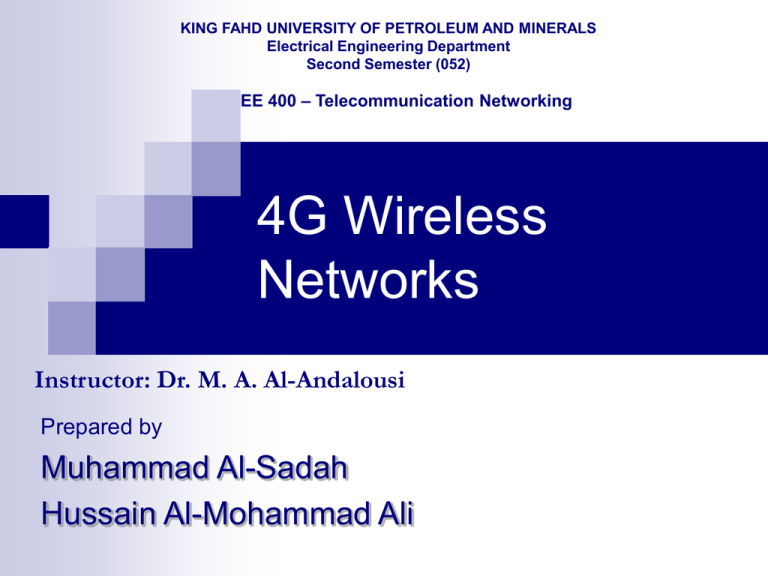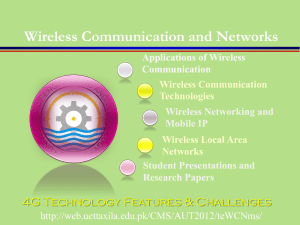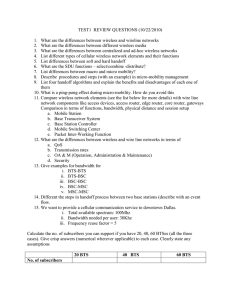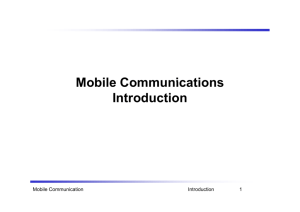4G - King Fahd University of Petroleum and Minerals
advertisement

KING FAHD UNIVERSITY OF PETROLEUM AND MINERALS Electrical Engineering Department Second Semester (052) EE 400 – Telecommunication Networking 4G Wireless Networks Instructor: Dr. M. A. Al-Andalousi Prepared by Muhammad Al-Sadah Hussain Al-Mohammad Ali Outline Introduction What is 4G? What's New in 4G? 3G vs. 4G 4G Network Features How 4G works Challenges Summary What is 4G? A wireless access technology and is the successor of 3G. Called "3G and Beyond". Enables seamless roaming between technologies. Plans on releasing the first commercial network in 2010. NTT DoCoMo Company is testing 4G communication at 100 Mbps while moving, and 1 Gbps while stationary. What's New in 4G? Entirely packet-switched networks. All network elements are digital. Higher bandwidths to provide multimedia services at lower cost (up to 100Mbps). Tight network security. Features of 4G Networks 4G networks are all-IP (Internet Protocol) based heterogeneous networks This will allow users to: Select any system at any time and any where Use Multiple systems at the same time (e.g. GPS and WLANs and CDMA) A wide range of applications using only one 4G integrated terminal Features of 4G Networks (cont.) Support interactive multimedia services: teleconferencing, wireless Internet, etc. Wider bandwidths, higher bit rates. Global mobility and service portability. Low cost. Scalability of mobile networks (>10 times the capacity of 3G). 3G vs. 4G 3G (including 2.5G) 4G Major Requirement Driving Architecture Predominantly voice driven data was always add on Converged data and voice over IP Network Architecture Wide area cell-based Hybrid - Integration of Wireless LAN (WiFi, Bluetooth) and wide area Speeds 384 Kbps to 2 Mbps 20 to 100 Mbps in mobile mode Frequency Band Dependent on country or continent (1800-2400 MHz) Higher frequency bands (2-8 GHz) Bandwidth 5-20 MHz 100 MHz (or more) Switching Design Basis Circuit and Packet All digital with packetized voice Access Technologies W-CDMA, 1xRTT, Edge OFDM and MC-CDMA (Multi Carrier CDMA) Forward Error Correction Convolution rate 1/2, 1/3 Concatenated coding scheme Component Design Optimized antenna design, multi-band adapters multi-band adapters Smarter Antennas, software multiband and wideband radios IP A number of air link protocols, including IP 5.0 All IP (IP6.0) From : www.mobileinfo.com How 4G works (working principle) The IP address is based on IPv6. IPv4: X.X.X.X example: 216.37.129.9 IPv6: 4 × IPv4 (32 bits) (128 bits) example: 216.37.129.9 , 79.23.178.229 , 65.198.2.10 , 192.168.5.120 home address care-of address mobile IP address local network address IPv4 vs. IPv6 IPv4 IPv6 Structure 32 bits 128 bits Security Poor security Enhance security Function Addressing 1. 2. Multi-fun. and mobile fun. are built-in Plug & Play (Auto-Configuration) The 4G mobile network(s) HAPS Satellite GSM Wireline or Wireless Networks (Internet) Services Bluetooth Care-ofMobile Add. IP Add. WLAN UMTS Content ADSL Home Add. Care-of Add. OFDM Very wide area Unspecified Wide area TDMA FDD WCDMA TD-CDMA Metropolitan area OFDM TDD Local area Direct Sequence Frequency Hopping Personal area 4G Systems Challenges To migrate current systems to 4G with the features mentioned previously, researchers are facing a number of challenges These challenges are grouped into the following different aspects: Accessing Different Networks: Multimode Devices Overlay Network Terminal Mobility Location Management Handoff Management 4G Wireless Networks Challenges First Challenge: Accessing Different Networks One of the most challenging problems facing deployment of 4G technology is how to access several and different mobile and wireless networks There are two possible architectures Multimode Devices Overlay Network First Challenge: Accessing Different Networks 1. Multimode Devices Architecture A single physical terminal with multiple interfaces to access the different wireless networks Advantages: Improve call completion Expand coverage area Reliable coverage in case of network, link or switch failure Disadvantages: Complexity in the hardware of the device Handoff Mechanism: Performed by the user, device or network Multimode Devices Architecture (cont.) To reduce the complexity of the hardware in the device the most promising technology is to adapt the software radio approach bandpass filter BPF Low noise amplifier LNA Analog/digital converter Baseband ADC DSP Digital Analogue An ideal software radio system reprogrammable User Multimode Devices Architecture (cont.) Challenges in software radio technology High number of antennas: Still It is impossible to have just one antenna and one LNA to cover the bands of all 4G wireless networks The low speed of ADCs. the speed of the fastest current ADC is still two to three times slower than required First Challenge: Accessing Different Networks 2. Overlay Network Architecture A user accesses an overlay network consisting of several UAPs UAPs Functions: Select a wireless network based on availability and user choices Store IPs of user, network and devices Advantages: Simplify hardware of device Supports single billing Disadvantages: More network devices Handoff Mechanism between UAPs: Performed by overlay network rather than the user or device 4G Wireless Networks Challenges Second Challenge: Terminal Mobility In order to provide wireless services at any time and anywhere, terminal mobility is a must in 4G infrastructure Terminal mobility allows mobile clients to roam across geographical boundaries of the wireless networks There are two main issues in terminal mobility: location management handoff management Second Challenge: Terminal Mobility 1. Location Management The system tracks and locates a mobile terminal for possible connection Location management involves handing all the information about Roaming terminals such as original and current location cells Authentication information QoS capabilities Second Challenge: Terminal Mobility 2. Handoff Management Maintain ongoing communication when the terminal roams IP changes during handoff : IPv6 within the same cell: 216.37.129.9, home address 79.23.178.229, care-of address 65.198.2.10, mobile IP address 192.168.5.120 local network address Second Challenge: Terminal Mobility 2. Handoff Management IPv6 when the terminal roams to another cell: 216.37.129.9, home address 79.23.178.229, care-of address 65.198.2.10, mobile IP address 192.168.5.120 local network address Handoff Management (cont.) Handoff Management Challenges • Horizontal handoff is performed when the terminal moves from one cell to another within the same wireless system. • Vertical handoff is performed when the terminal moves between two different wireless systems (e.g., from WLAN to GSM) . Challenges in Handoff Management Vertical & Horizontal handoff will increase System load (increasing control packets) Packet losses Handover latency Hard correct handoff time: because measuring handoffs is done among different wireless systems Summary The key concept behind 4G systems is integrating their capacities with all of the existing mobile technologies through advanced technologies The IP address system used in 4G is based on the new technology IPv6. 4G networks is still in the development stage, and in order to utilize their new features too many challenges must be overcome References Upkar Varshney and Radhika Jain, Issues in Emerging 4G Wireless Networks, Georgia State Jain, Issues in Emerging 4G Wireless Networks, Georgia State University. Available:http://www.ee.oulu.fi/~skidi/teaching/mobile_and_ubiquitous_multim edia_2002/issues_in_emerging_4G_wireless_networks.pdf Erik Fledderus, Bingulac, Broadband Radio; a vision on 4G, KPN Research, The Netherlands. Available: http://www.brabantbreedband.nl/publications/URSIGA2002%20ER%20Fledderus.pdf Ibrahim,Jawad “4G Features,” Bechtel Telecommunications Technical Journal (Vol.1 No.1), Dec. 2002 Yu Hui, Suk and Kai Hau Yeung, City University of Hong Kong: Challenges in the Migration to 4G Mobile Systems. Available: http://ieeexplore.ieee.org/iel5/35/28028/01252799.pdf Wikipedia, the free encyclopedia. http://en.wikipedia.org/wiki/4G References (cont.) Z. Theodore, “Migration toward 4G Wireless Communications,” IEEE Wireless Communication, June. 2004 U. Narumi, O. Toru, and M. Tatsuro “Overview of Fourth-generation Mobile Communication System,” NTT Technical Review (Vol.2 No.0), Sep. 2004









